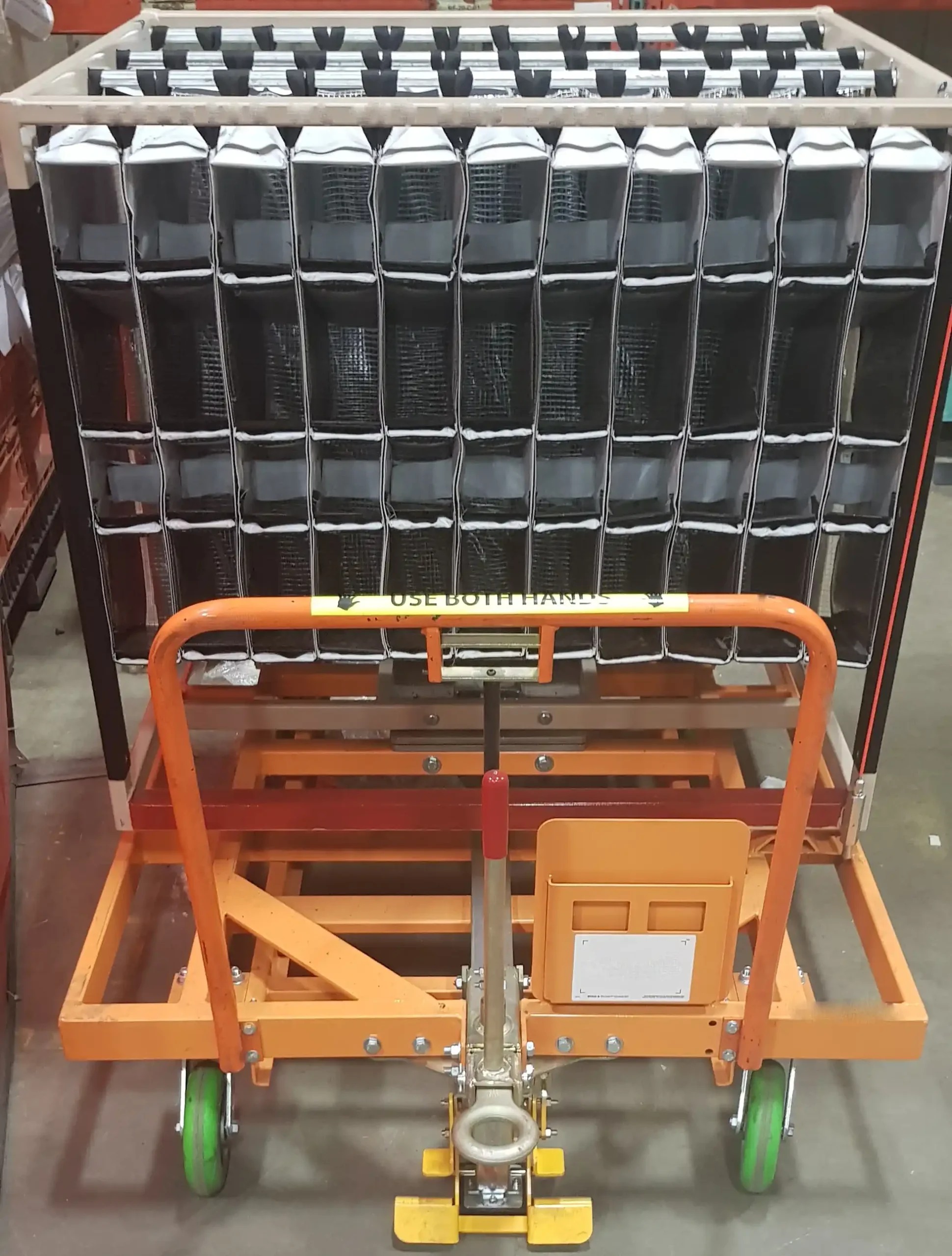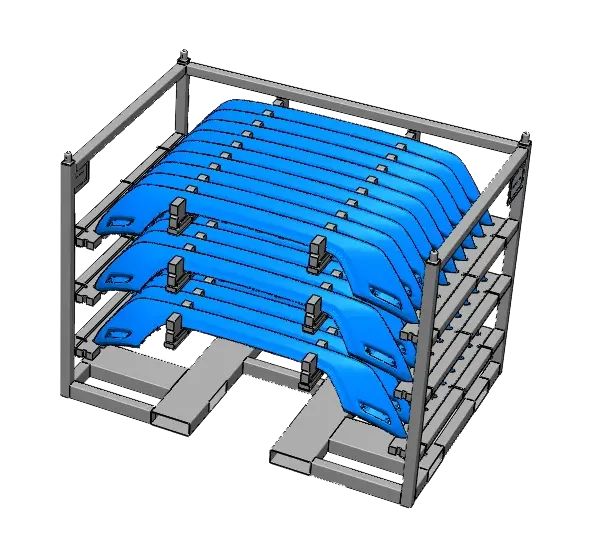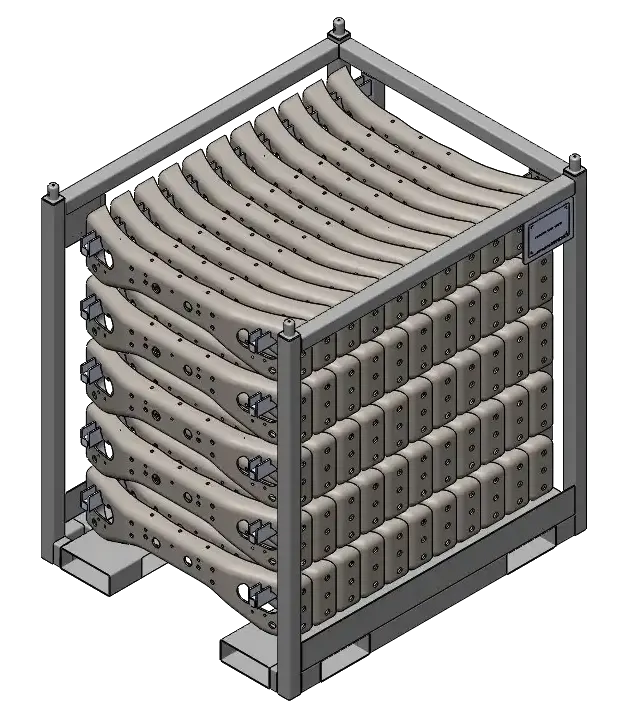Discover how custom wire racks can maximize space, enhance organization, and cater to specific needs across various industries.
Read MoreHigh Density Racking: A Transformational Storage Solution
What is High Density Racking?
High density racking is a storage solution that allows you to maximize the storage efficiency of your warehouse or facility. It is designed to optimize space utilization by utilizing vertical space and reducing the amount of floor space required for storage. Instead of traditional racking systems, which often have large aisles between racks, high density racking systems are built with narrow aisles or utilize automated mechanisms to retrieve items. This allows for more storage capacity within the same footprint.

Benefits of High Density Racking
Implementing high density racking systems in your warehouse offers a range of benefits that can greatly improve your storage efficiency and overall operational effectiveness. Some of the key benefits include:
-
Maximizing Storage Capacity: High density racking allows you to store more items within a limited floor space. By utilizing vertical space and reducing aisle width, you can significantly increase your storage capacity.
-
Improved Accessibility: These racking systems are designed to provide easy and quick access to stored items. Whether through narrow aisles or automated retrieval systems, accessing the inventory becomes faster and more efficient.
-
Enhanced Organization: With high density racking, you can optimize your storage layout and create a more organized system. This makes it easier to locate specific items and facilitates inventory management.
-
Increased Productivity: By streamlining the storage process and reducing the time spent on locating and retrieving items, these racking systems can significantly improve productivity in your warehouse.
-
Cost Savings: By maximizing your storage capacity and improving efficiency, high density racking can help reduce costs associated with warehousing, such as the need for larger facilities or expansion.
Types of High Density Racking
There are several types of high density racking systems available, each with its own advantages and applications. The choice of system depends on factors such as the type of inventory, storage requirements, and accessibility needs. Some common types of these systems include:
-
Drive-in/Drive-through Racking: This system allows forklifts to drive directly into the racking structure, stacking pallets side by side on multiple levels. It is ideal for storing large quantities of the same product or slow-moving inventory.
-
Push-back Racking: Push-back racking operates on a first-in-last-out (FILO) principle, where pallets are loaded from the aisle and pushed back along inclined rails as new pallets are loaded. When unloading, the last pallet loaded becomes the first one to be removed.
-
Pallet Flow Racking: This system relies on gravity to move pallets from the loading end to the unloading end. Pallets are loaded from one side and flow along rollers or wheels to the other side for unloading. Ultimately, this is an efficient system for high-density storage with a high turnover rate.
-
Vertical Lift Modules (VLM): VLM systems utilize vertical space by storing items in enclosed units with shelves or trays that can be automatically retrieved and delivered to an operator. In fact, they are particularly useful for small parts or components and can save significant floor space.
How Does High Density Racking Work?
High density racking systems are designed to maximize storage capacity by utilizing available space and optimizing accessibility. The specific workings of each system may vary depending on the type chosen, but the general principles remain the same.
In a high density racking system, items are stored in individual pallets or containers. These pallets or containers are then placed on racks, which can be accessed through narrow aisles or a mechanized retrieval system. By reducing the aisle width, more space is allocated to storage, allowing for a higher storage density.
For example, in a drive-in/drive-through racking system, forklifts drive directly into the racks to deposit or retrieve pallets. This eliminates the need for multiple aisles, as the forklifts can access the inventory from both sides of the racks.
In a push-back racking system, each level of the rack is equipped with inclined rails. As new pallets are loaded from the aisle, they push back the existing pallets, allowing for a higher density of storage.
Pallet flow racking relies on gravity to move pallets from the loading end to the unloading end. The pallets are loaded from one side and flow along rollers or wheels to the other side, where they can be easily accessed and unloaded.
Vertical lift modules (VLM) use an automated system to retrieve and deliver items stored in enclosed units with shelves or trays. With the push of a button, the VLM retrieves the required item and brings it to an operator at a convenient height, maximizing accessibility and space utilization.
The specific mechanism and operation of each high density racking system may vary, but the goal remains the same: to maximize storage capacity and streamline the storage process.
Factors to Consider When Choosing High Density Racking
When selecting a high density racking system for your warehouse, there are several factors that need to be considered to ensure the best fit for your storage needs. These factors include:
-
Storage Needs: Assessing your storage needs is crucial in determining the type of high density racking system that will work best for your inventory. Consider factors such as the type and size of items, turnover rate, and storage volume required.
-
Accessibility: Determine how frequently and easily you need to access your stored items. Some high density racking systems provide better accessibility than others, depending on the type of goods being stored and the operational requirements.
-
Space Utilization: Evaluate your available space and determine the optimal utilization of that space. High density racking systems are designed to maximize storage capacity and minimize the floor space required, so analyze the space constraints and choose a system that best fits your needs.
-
Safety: Ensure that the chosen high density racking system meets all safety requirements and regulations. Consider safety features such as load capacity, stability, reinforcement, and accident prevention measures.
-
Future Considerations: Plan ahead and consider potential future requirements. Will your storage needs change in the future? Will the chosen high density racking system allow for scalability and adaptation to evolving needs?
By carefully considering these factors, you can make a well-informed decision and choose the racking system that best meets your storage requirements.

Designing High Density Racking Systems
Designing an effective high density racking system involves several key steps to ensure that it maximizes storage efficiency while meeting your specific needs. The following steps provide a framework for designing this racking system:
1. Assessing your storage needs
Before designing a high density racking system, it is essential to assess your storage needs thoroughly. Considerations for this assessment include the type and size of items you will be storing, the volume of items, the turnover rate, and any specific requirements unique to your operations.
Considerations for storage needs assessment:
- Type and size of items: Determine the dimensions and weight of your inventory. This will help determine the appropriate racking system and the load capacity required.
- Volume of items: Evaluate the volume of items you need to store. This will impact the overall space requirements.
- Turnover rate: Consider the frequency at which items will be accessed. Faster turnover may require systems with better accessibility.
- Unique requirements: Identify any specific requirements or constraints unique to your operations. For example, if you are handling perishable goods, you may need a system that allows for proper ventilation or temperature control.
2. Selecting the right type of racking system
Once you have assessed your storage needs, you can select the most suitable high density racking system for your warehouse. Consider the advantages and applications of each type of system and choose one that aligns with your specific requirements.
3. Optimizing space utilization
After selecting the racking system, focus on optimizing space utilization within your warehouse. This involves designing the layout to maximize the storage capacity while maintaining efficient aisle widths and access routes.
Strategies for maximizing space utilization:
- Vertical storage: Utilize vertical space by stacking items to the maximum height allowed by the racking system.
- Compact storage: Use advanced stacking methods or automated mechanisms to minimize wasted space.
- Narrow aisles: Opt for narrower aisles to allocate more floor space to storage.

How to Implement High Density Racking in Your Warehouse
Implementing a high density racking system requires careful planning and execution. Follow these steps to ensure a successful implementation:
Step-by-step guide to implementing high density racking:
-
Assess your storage needs: Evaluate your inventory, volume, and turnover rate to determine the appropriate racking system for your warehouse.
-
Choose the right system: Select the most suitable racking system based on your storage needs, space availability, and operational requirements.
-
Design the layout: Plan and design the layout of the racking system, considering space optimization, accessibility, and safety.
-
Prepare the space: Clear the area and make any necessary modifications or additions to accommodate the high density racking system.
-
Install the system: Follow the manufacturer’s instructions to install the racking system correctly, and ensure all safety measures are implemented during the installation process.
-
Train employees: Provide thorough training to warehouse staff on how to safely operate the racking system, including proper loading and unloading procedures.
-
Test and adjust: Conduct thorough testing of the system to ensure proper functionality and compatibility with your inventory, and make any necessary adjustments or modifications as needed.
-
Monitor and optimize: Regularly monitor the performance of the high density racking system and make adjustments to optimize efficiency and address any issues.
By following these steps, you can successfully implement a high density racking system in your warehouse and reap the benefits of improved storage efficiency.
Conclusion
High density racking systems present a valuable solution for maximizing storage efficiency in warehouses and facilities of all sizes. By utilizing vertical space, optimizing storage layouts, and improving accessibility, these innovative systems offer significant benefits such as increased storage capacity, improved organization, enhanced productivity, and cost savings.
When considering implementing a high density racking system, it is crucial to assess your storage needs, select the appropriate system, optimize space utilization, prioritize safety, plan for future needs, and follow a step-by-step implementation process. With proper maintenance and upkeep, a high density racking system can provide long-term benefits and contribute to the success of your warehouse operations.
By understanding the advantages of high density racking systems over traditional racking systems, businesses can make informed decisions to optimize their storage efficiency and increase overall operational effectiveness.

Customize Your Own & Get a FREE Estimate!
Simply e-mail us at sales@plexformps.com with all your information
OR call us today & speak to one of our packaging professionals









